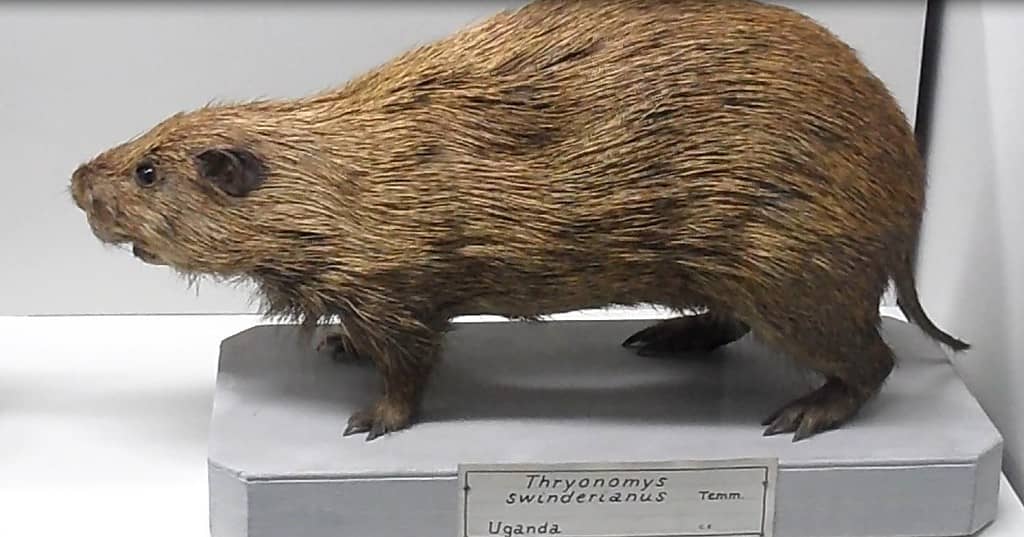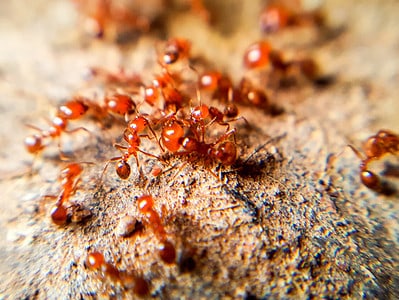Often eaten as bush meat or as livestock
Advertisement
Cane Rat Scientific Classification
Read our Complete Guide to Classification of Animals.
Cane Rat Conservation Status
Cane Rat Facts
- Name Of Young
- Pup
- Group Behavior
- Family units
- Fun Fact
- Often eaten as bush meat or as livestock
- Estimated Population Size
- Tens or hundreds of millions
- Biggest Threat
- Human activities
- Most Distinctive Feature
- Large, stocky bodies
- Distinctive Feature
- Coarse, bristly hair
- Other Name(s)
- Grasscutters
- Gestation Period
- 3 to 5 months
- Litter Size
- 2-4
- Habitat
- Riparian environments, wetlands, or grassy hills
- Predators
- Birds, snakes, dogs, hyenas
- Diet
- Herbivore
- Lifestyle
- Nocturnal
- Favorite Food
- Grasses, sugarcane
- Number Of Species
- 1
- Location
- Africa
Cane Rat Physical Characteristics
- Color
- Brown
- Grey
- Yellow
- Skin Type
- Hairs
- Lifespan
- Up to 4 years
- Weight
- Up to 22 pounds
- Length
- Up to 24 inches long
- Age of Sexual Maturity
- 6 months to 1 year
- Venomous
- No
- Aggression
- Low
View all of the Cane Rat images!
Also known as grasscutters, cane rats are large rodents in the family Thryonomyidae. These giant rodents can measure up to 24 inches long and weigh in excess of 22 pounds. This rodent live throughout sub-Saharan Africa, particularly in eastern and west-central Africa. Farmers go to great lengths to keep them out of their fields, as they are a common pest of many agricultural crops. In many places, people eat them as bush meat or raise them as livestock.
5 Cane Rat Facts
- They are herbivores that feed on grasses, fruits, bark, and numerous types of agricultural crops.
- In the wild, they can live up to 4 years old.
- They live in small family groups led by a single dominant male.
- When frightened, they may grunt, stamp their feet, or run toward the water.
- Although they possess poor eyesight, they have an excellent sense of hearing and smell.
Scientific Name
They belong to the rodent order Rodentia, which includes rats, mice, squirrels, and prairie dogs. It is a member of the infraorder Hystricognathi, a suborder of rodents characterized by the unique bone structure of their skulls. Hystricognath rodents include them, chinchillas, guinea pigs, agoutis, naked mole rats, and capybaras.
They belong to the genus Thryonomys, the sole extant genus in the family Thryonomyidae. The family name derives from the Greek word thyron, meaning “rush” or “reed,” and mys, meaning “mouse.” Today, there exists two extant species of cane rat – the greater cane rat (Thryonomys swinderianus) and the lesser cane rat (Thryonomys gregorianus). The greater cane rat’s specific name, swinderianus, is of unknown origin, but may derive from the Old English swin, or “pig,” due to its large size. Meanwhile, the lesser cane rat’s specific name, gregorianus, may stem from the Ancient Greek γρήγορος (grḗgoros), meaning “watchful” or “alert.” Most likely, its specific name references the lesser cane rat’s habit of grunting and stamping its feet as a warning when predators are nearby.
Appearance
They possess heavy, stocky bodies. Their coarse, bristly hair appears light brown or grey with specks of yellow. They have short, blunt muzzles and small, round ears. The tail features little to no hair and makes up around a quarter of the total body length. As their name implies, greater cane rats measure larger than lesser cane rats. In fact, they can grow nearly twice as large as their smaller cousins. Lesser cane rats measure between 13 and 15 inches long, while greater cane rats range from 17 to 24 inches long. In both species, males typically measure longer and weigh more than females. On average, lesser cane rat males weigh between 3.1 and 5.3 pounds, while females weigh from 4 to 4.2 pounds. Meanwhile, greater cane rats typically weigh between 7.1 and 11.5 pounds. However, especially large specimens can weigh upwards of 22 pounds.

Cane rats possess heavy, stocky bodies.
©1,198 × 630 pixels, file size: 963 KB, MIME type: image/png – License
Evolution and History
According to fossil records, they emerged in Africa between 2 and 4 million years ago. Cane rats have no living relatives, as well other genera in the family Thryonomyidae are now extinct. Scientists have found fossils of extinct genera that bear a resemblance to them throughout Africa, Asia, and the Mediterranean. According to these records, experts believe that the first members of the Thryonomyidae family emerged between 33.7 and 37 million years ago during the Late Eocene Epoch.
Behavior
Like many rodents, they are primarily nocturnal and mostly move around at night. That said, they can occasionally get active during the day. They possess poor eyesight, so they rely on their keen sense of smell and hearing. When they detect predators, they may grunt and stamp their feet to warn other nearby cane rats. They also use grunts and whistles to communicate with other members of their group. They are excellent swimmers and can move quickly both on land and in water. Evidence suggests that greater cane rats often run toward the water when frightened.
Habitat
You can find them throughout much of sub-Saharan Africa. They range from Senegal in west Africa to Kenya in east Africa. In west Africa, they range as far south as the Republic of Congo. Meanwhile, in east Africa, they range all the way to the southern coast of South Africa. However, they are largely absent from south-central and southwestern Africa.
They often construct burrows underground but may also build nests made of grass aboveground. Although the ranges of lesser and greater cane rats overlap, they prefer different types of habitats. Generally speaking, greater cane rats are the more aquatic of the two species. Greater cane rats frequently live near lakes, rivers, or swamps. You can often find them among reeds or tall, dense grass. Meanwhile, lesser cane rats prefer to live in grassy, moist savannas. They often frequent rocky hills with tall grass.
Diet
Unlike most rats, these are herbivores. In the wild, their diet consists primarily of grasses, as well as bark and fruits. Meanwhile, those that live close to human settlements often turn to eating mostly agricultural crops. Some crops that they frequently target include sugarcane, corn, cassava, pineapple, and eggplant. As a result, farmers often view them as pests and go to great lengths to keep them out of their fields.
Predators and Threats
Common predators include wild dogs, hyenas, snakes, and large birds of prey such as hawks and eagles. That said, the largest threat to cane rats comes from humans. Humans have long hunted them for food. Farmers also often kill cane rats to keep them out of their crops.
Reproduction, Babies, and Lifespan
They reach sexual maturity between 6 months and one year old. They live in small family groups that can contain anywhere from 8 to 12 members. Each family is led by a single dominant male and contains several breeding females. Lesser cane rats normally give birth during the rainy season, and females can deliver up to 2 litters per year. The gestation period lasts around 3 months, after which females give birth to 2 or 3 pups. Meanwhile, the gestation period for greater cane rats lasts around 5 months. Additionally, female greater cane rats almost always give birth to 4 pups. On average, they can live anywhere from 3 to 4 years in the wild.
Population
In recent years, the demand for their meat has increased. As a result, more and more people are raising them as livestock. Meanwhile, despite the clearing of native habitats for agricultural use, they continue to thrive in the wild. In fact, some evidence suggests their populations may be increasing due to greater availability of food. Presently, the IUCN classifies both species of cane rat as Least Concern.
In the Zoo
They are not popular zoo attractions. As a result, you’re not likely to encounter them in many large, internationally-renowned zoos. Your best bet to see them is to visit sub-Saharan Africa. There you’re very likely to encounter either wild or domesticated cane rats kept as livestock.
View all 235 animals that start with CCane Rat FAQs (Frequently Asked Questions)
Are cane rats omnivores, herbivores, or carnivores?
Cane rats are herbivores that primarily live on grasses, bark, and fruit in the wild. However, cane rats that live close to human population centers often adapt to eating agricultural crops.
Are cane rats the largest rodents in Africa?
The greater cane rat ranks as the second largest rodent in Africa. In terms of size, only the porcupines in the genus Hystrix measure larger.
What does cane rat taste like?
Many people in Africa eat wild and domesticated cane rats. Cane rats have long been prized as bush meat and are now frequently raised as livestock. According to sources, cane rat meat is quite tender and sweet. Their meat contains relatively little fat and high levels of protein.
Are cane rats aggressive?
Female cane rats and non-dominant male cane rats are relatively docile. However, dominant males can grow quite aggressive and will not tolerate the presence of other males.
Thank you for reading! Have some feedback for us? Contact the AZ Animals editorial team.
Sources
- , Available here: https://eol.org/pages/41996/articles
- , Available here: https://www.sciencedirect.com/science/article/pii/S2468227621000892
- , Available here: https://www.bbc.com/future/article/20151207-the-countries-where-rats-are-on-the-menu
- , Available here: https://www.krugerpark.co.za/africa_greater_cane_rat.html
















